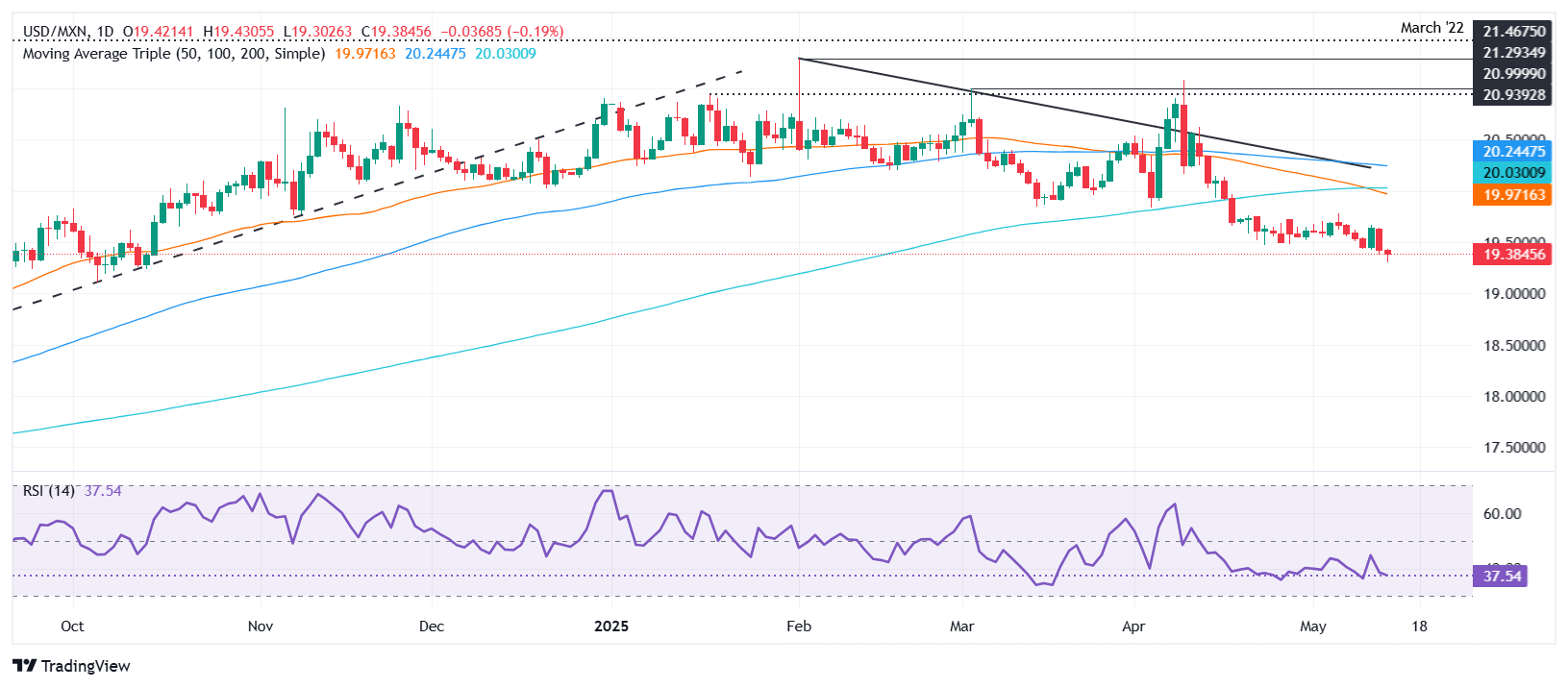Mexican Peso hits 7-month high amid weak US Dollar, eyes on Banxico
- The Mexican Peso strengthens as US-China tariff pause boosts risk appetite; USD retreats after a rally on policy shift rumors.
- Banxico set to cut rates for seventh straight time, narrowing rate gap with US and tempering further MXN gains.
- Goldman Sachs revises Mexico’s 2025 GDP forecast to 0%, improving from prior -0.5% outlook.
The Mexican Peso (MXN) extended its gains on Wednesday, hitting a seven-month high against the US Dollar (USD) as the latter retreated somewhat amid an improvement in market sentiment fueled by the US-China trade truce. At the time of writing, USD/MXN trades at 19.39, down 0.98%.
The US equity markets are trading mixed, as the three major US indices have turned positive in the year following their slide, which began on April 2, the so-called US Liberation Day. Rumors that the White House favors a weakened US Dollar dissipated, as an article in Bloomberg stated that US officials “are not working to include currency policy pledges in the agreements, according to a person familiar with the matter.”
In Mexico, the economic schedule remained absent on Tuesday and Wednesday. Nevertheless, Banco de Mexico (Banxico) will reveal its monetary policy on Thursday. Economists expect a 50-basis-point (bps) rate cut, the seventh straight reduction to Mexico’s main reference rate.
Banxico’s decision will reduce the interest rate differential between Mexico and the US. This favors further USD/MXN upside, but a sudden change in Mexico’s economic outlook would cap the exotic pair gains.
Goldman Sachs has upwardly revised Mexico’s economic growth for 2025 to 0% from the previously projected 0.5% contraction.
In the US, the economic docket will feature inflation figures on the producer side, Retail Sales data, and Fed Chair Jerome Powell's speech.
Daily digest market movers: Mexican Peso rallies sharply ahead of Banxico’s decision
- If Banxico reduces rates by 50 bps, it would mark a cumulative 250 bps of easing after the central bank embarked on its easing cycle.
- Recently, Mexico’s Economy Minister, Marcelo Ebrard, announced that the USMCA revision will commence in the second half of 2025.
- On Monday, Mexico’s Industrial Production slowed in March, as revealed by the Instituto Nacional de Estadística, Geografía e Informática (INEGI). This, combined with GDP figures that narrowly avoided A technical recession, is likely to undermine the Mexican currency.
- Notably, investors reduced their bets that the Federal Reserve (Fed) will only cut rates twice rather than thrice this year, as indicated by data from the Chicago Board of Trade (CBOT). The December 2025 fed funds rates futures contract shows that market players expect 57 basis points of easing.
- Therefore, monetary policy divergence between the Fed and Banxico might add pressure on the Peso and push the USD/MXN exchange rate higher.
USD/MXN technical outlook: Mexican Peso skyrockets, with USD/MXN poised to test 19.00
USD/MXN downtrend resumed on Wednesday as the pair hit a multi-month low of 19.29, with traders eyeing the 19.00 figure. A breach of these two levels could pave the way for a challenge to the August 19, 2024, swing low of 18.59. From a momentum standpoint, the Relative Strength Index (RSI) remains bearish. Therefore, further downside lies ahead.
Conversely, if USD/MXN climbs past the 19.50 area and reaches a three-day high of 19.66, surpassing the 20-day Simple Moving Average (SMA), it may retreat somewhat.

Mexican Peso FAQs
The Mexican Peso (MXN) is the most traded currency among its Latin American peers. Its value is broadly determined by the performance of the Mexican economy, the country’s central bank’s policy, the amount of foreign investment in the country and even the levels of remittances sent by Mexicans who live abroad, particularly in the United States. Geopolitical trends can also move MXN: for example, the process of nearshoring – or the decision by some firms to relocate manufacturing capacity and supply chains closer to their home countries – is also seen as a catalyst for the Mexican currency as the country is considered a key manufacturing hub in the American continent. Another catalyst for MXN is Oil prices as Mexico is a key exporter of the commodity.
The main objective of Mexico’s central bank, also known as Banxico, is to maintain inflation at low and stable levels (at or close to its target of 3%, the midpoint in a tolerance band of between 2% and 4%). To this end, the bank sets an appropriate level of interest rates. When inflation is too high, Banxico will attempt to tame it by raising interest rates, making it more expensive for households and businesses to borrow money, thus cooling demand and the overall economy. Higher interest rates are generally positive for the Mexican Peso (MXN) as they lead to higher yields, making the country a more attractive place for investors. On the contrary, lower interest rates tend to weaken MXN.
Macroeconomic data releases are key to assess the state of the economy and can have an impact on the Mexican Peso (MXN) valuation. A strong Mexican economy, based on high economic growth, low unemployment and high confidence is good for MXN. Not only does it attract more foreign investment but it may encourage the Bank of Mexico (Banxico) to increase interest rates, particularly if this strength comes together with elevated inflation. However, if economic data is weak, MXN is likely to depreciate.
As an emerging-market currency, the Mexican Peso (MXN) tends to strive during risk-on periods, or when investors perceive that broader market risks are low and thus are eager to engage with investments that carry a higher risk. Conversely, MXN tends to weaken at times of market turbulence or economic uncertainty as investors tend to sell higher-risk assets and flee to the more-stable safe havens.

